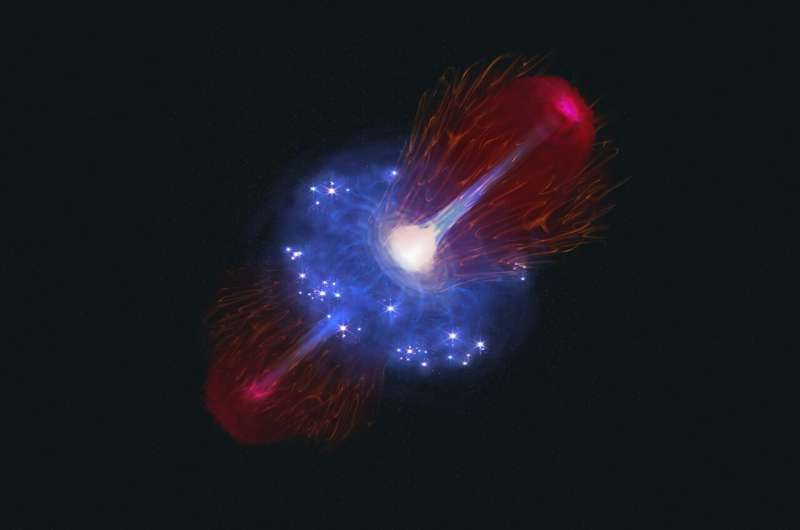
December 18, 2024 by Sarah Collins, University of Cambridge
Collected at: https://phys.org/news/2024-12-dormant-massive-black-hole-early.html
Scientists have spotted a massive black hole in the early universe that is “napping” after stuffing itself with too much food. Like a bear gorging itself on salmon before hibernating for the winter, or a much-needed nap after Christmas dinner, this black hole has overeaten to the point that it is lying dormant in its host galaxy.
An international team of astronomers, led by the University of Cambridge, used the NASA/ESA/CSA James Webb Space Telescope to detect this black hole in the early universe, just 800 million years after the Big Bang.
The black hole is huge—400 million times the mass of our sun—making it one of the most massive black holes discovered by Webb at this point in the universe’s development. The black hole is so enormous that it makes up roughly 40% of the total mass of its host galaxy: in comparison, most black holes in the local universe are roughly 0.1% of their host galaxy mass.
However, despite its gigantic size, this black hole is eating, or accreting, the gas it needs to grow at a very low rate—about 100 times below its theoretical maximum limit—making it essentially dormant.
Such an over-massive black hole so early in the universe, but one that isn’t growing, challenges existing models of how black holes develop. However, the researchers say that the most likely scenario is that black holes go through short periods of ultra-fast growth, followed by long periods of dormancy. Their results are reported in the journal Nature.
When black holes are “napping,” they are far less luminous, making them more difficult to spot, even with highly sensitive telescopes such as Webb. Black holes cannot be directly observed, but instead they are detected by the tell-tale glow of a swirling accretion disk, which forms near the black hole’s edges. The gas in the accretion disk becomes extremely hot and starts to glow and radiate energy in the ultraviolet range.
“Even though this black hole is dormant, its enormous size made it possible for us to detect,” said lead author Ignas Juodžbalis from Cambridge’s Kavli Institute for Cosmology. “Its dormant state allowed us to learn about the mass of the host galaxy as well. The early universe managed to produce some absolute monsters, even in relatively tiny galaxies.”
According to standard models, black holes form from the collapsed remnants of dead stars and accrete matter up to a predicted limit, known as the Eddington limit, where the pressure of radiation on matter overcomes the gravitational pull of the black hole. However, the sheer size of this black hole suggests that standard models may not adequately explain how these monsters form and grow.
“It’s possible that black holes are ‘born big,’ which could explain why Webb has spotted huge black holes in the early universe,” said co-author Professor Roberto Maiolino, from the Kavli Institute and Cambridge’s Cavendish Laboratory. “But another possibility is that they go through periods of hyperactivity, followed by long periods of dormancy.”
Working with colleagues from Italy, the Cambridge researchers conducted a range of computer simulations to model how this dormant black hole could have grown to such a massive size so early in the universe. They found that the most likely scenario is that black holes can exceed the Eddington limit for short periods, during which they grow very rapidly, followed by long periods of inactivity: The researchers say that black holes such as this one likely eat for 5 to 10 million years, and sleep for about 100 million years.
“It sounds counterintuitive to explain a dormant black hole with periods of hyperactivity, but these short bursts allow it to grow quickly while spending most of its time napping,” said Maiolino.
Because the periods of dormancy are much longer than the periods of ultra-fast growth, it is in these periods that astronomers are most likely to detect black holes. “This was the first result I had as part of my Ph.D., and it took me a little while to appreciate just how remarkable it was,” said Juodžbalis. “It wasn’t until I started speaking with my colleagues on the theoretical side of astronomy that I was able to see the true significance of this black hole.”
Due to their low luminosities, dormant black holes are more challenging for astronomers to detect, but the researchers say this black hole is almost certainly the tip of a much larger iceberg, if black holes in the early universe spend most of their time in a dormant state.
“It’s likely that the vast majority of black holes out there are in this dormant state—I’m surprised we found this one, but I’m excited to think that there are so many more we could find,” said Maiolino.
More information: Ignas Juodžbalis et al, A dormant overmassive black hole in the early Universe, Nature (2024). DOI: 10.1038/s41586-024-08210-5
Journal information: Nature

Leave a Reply